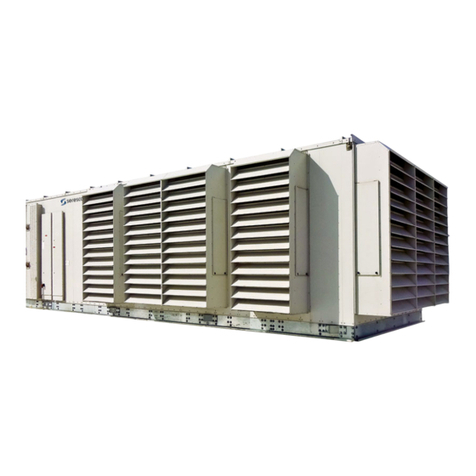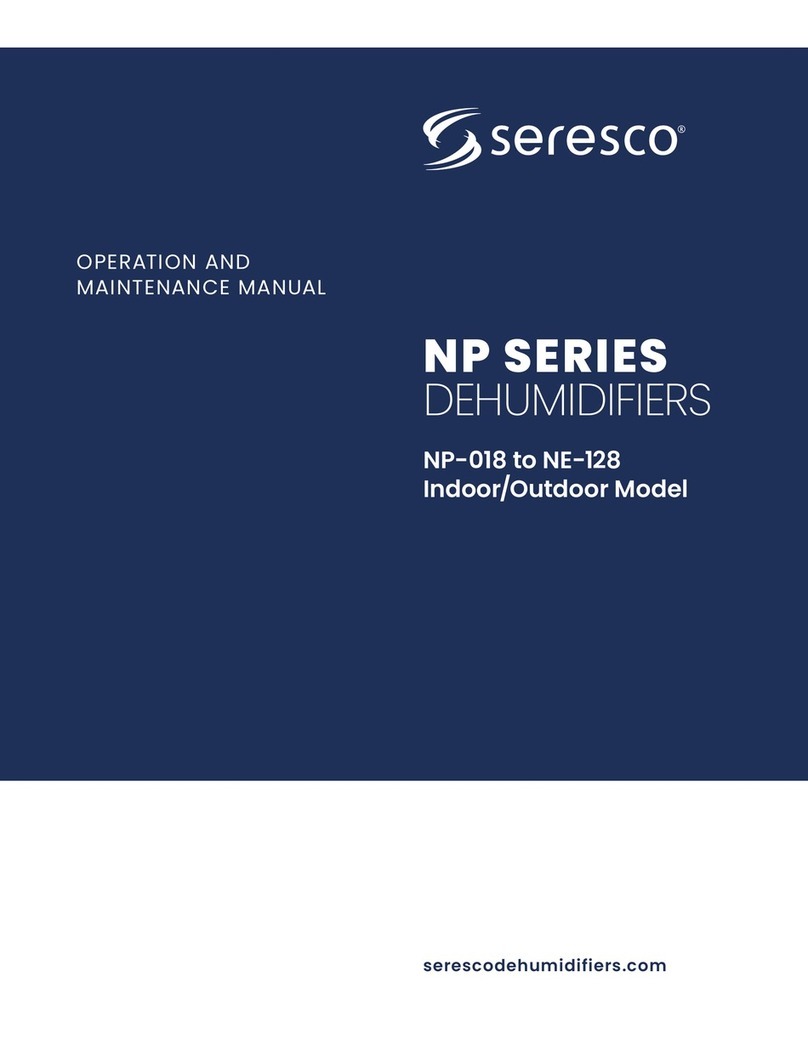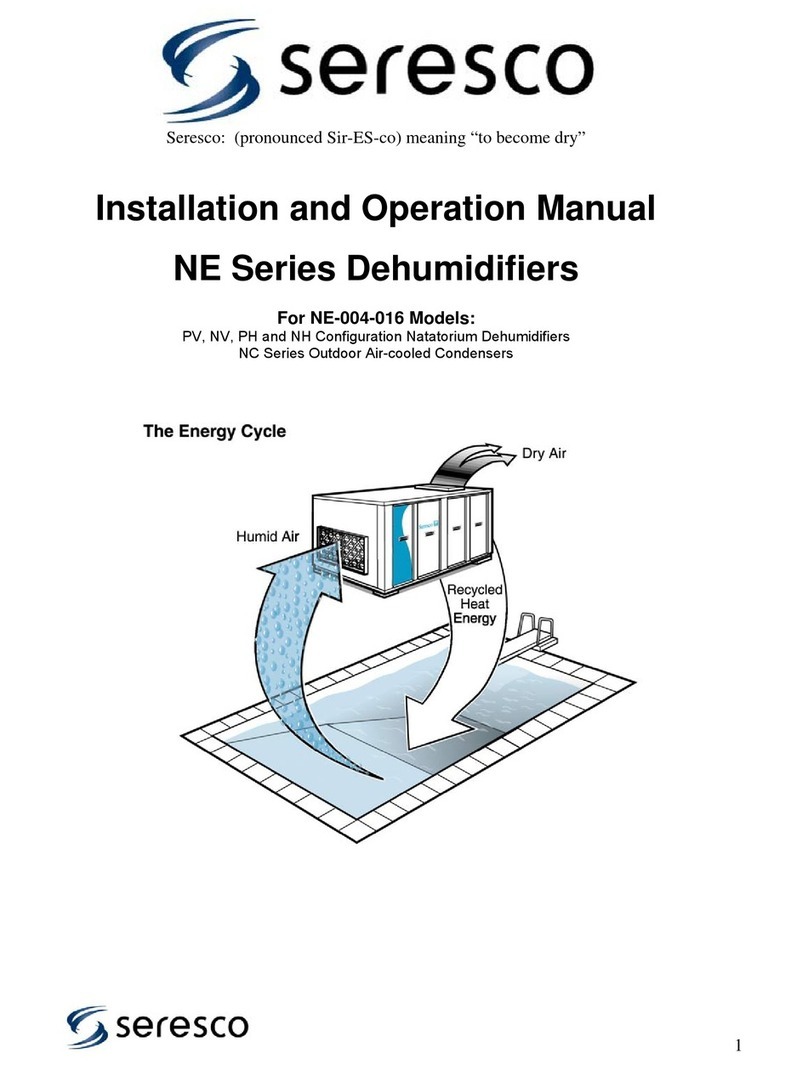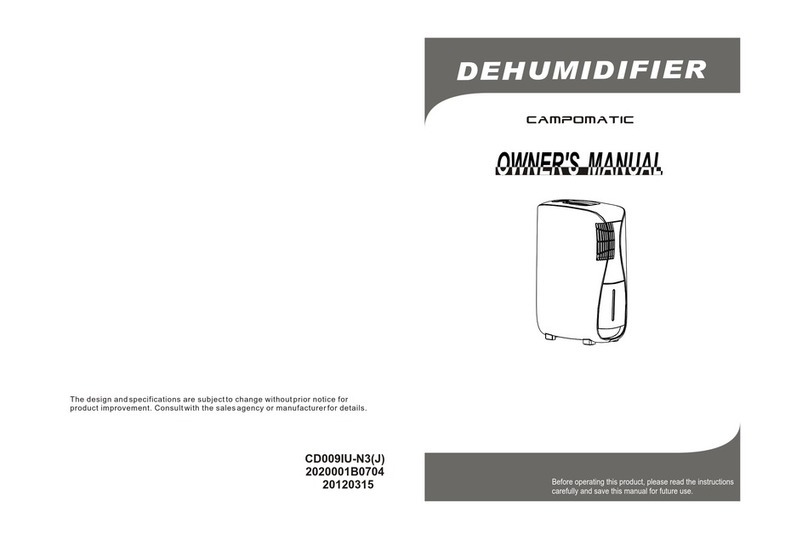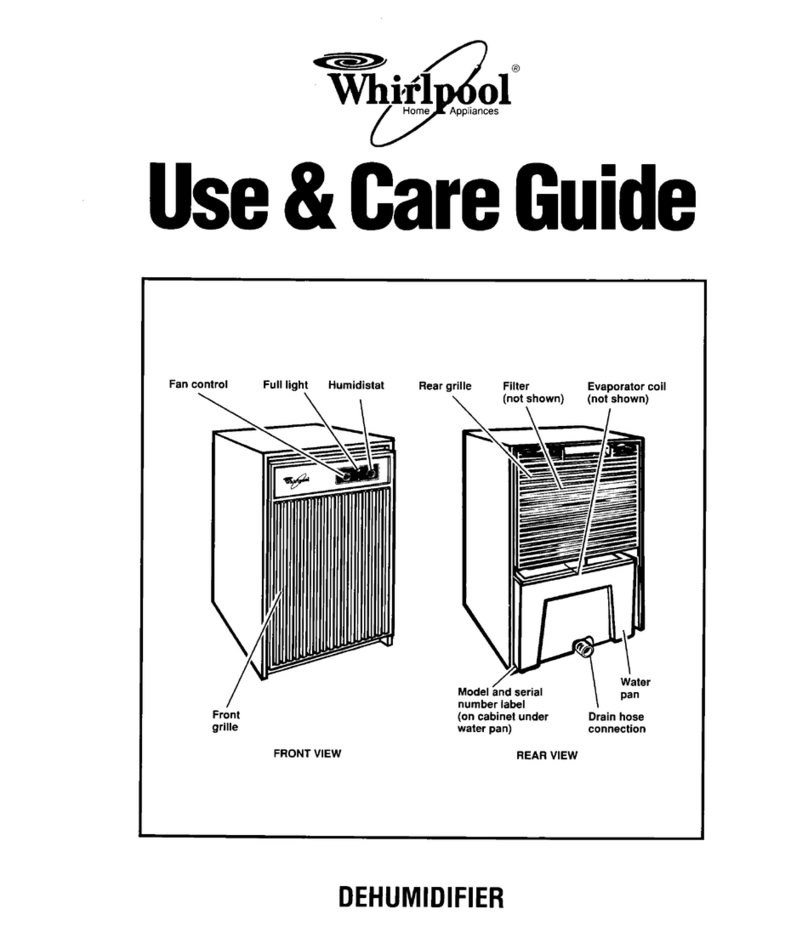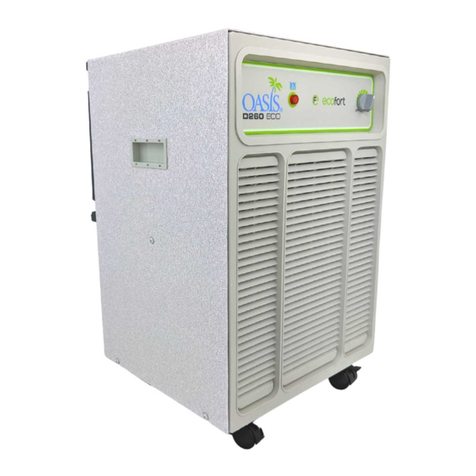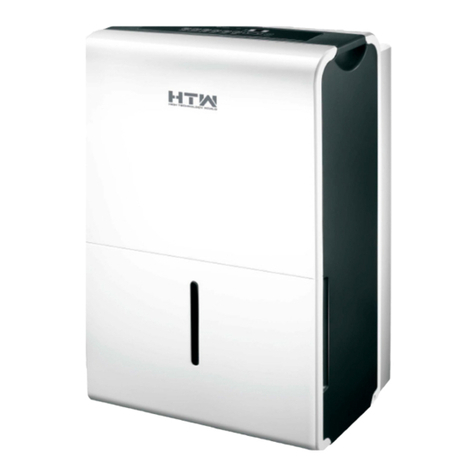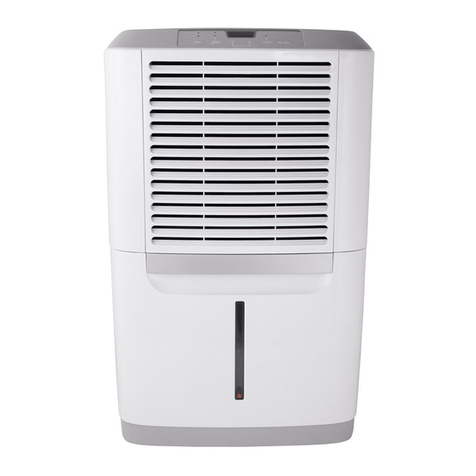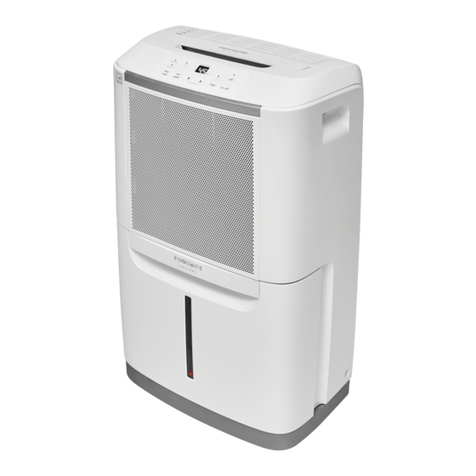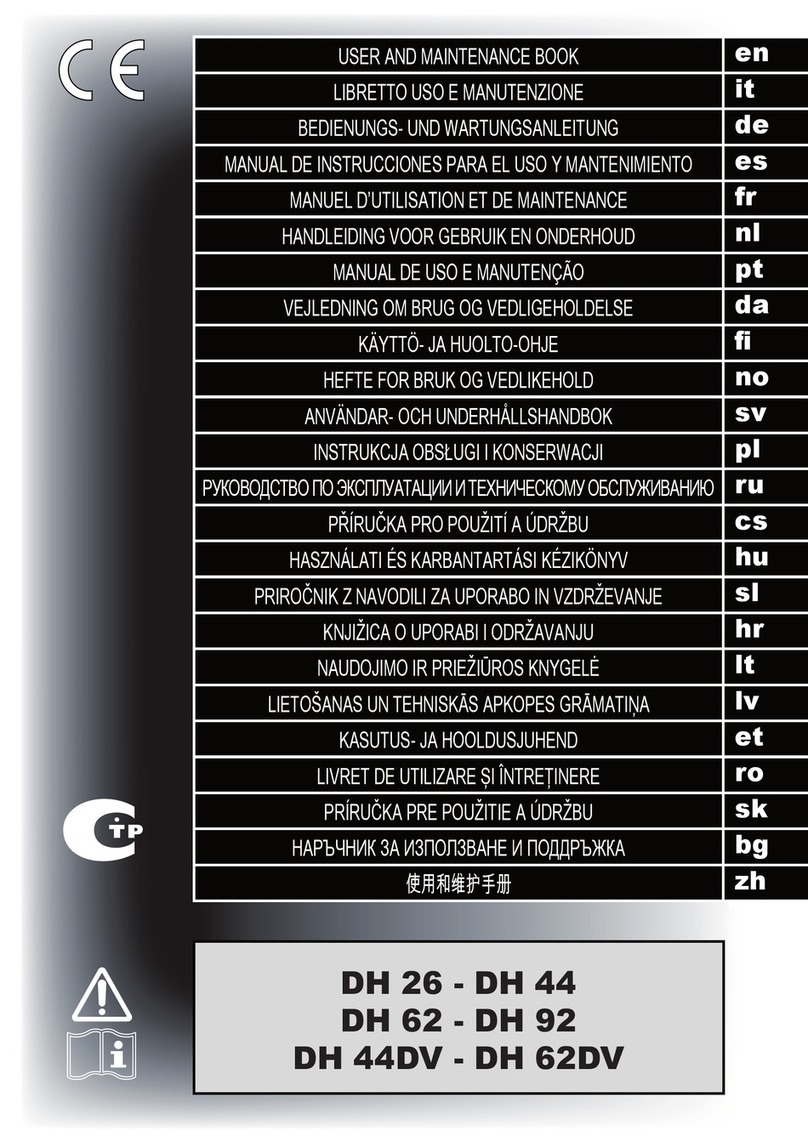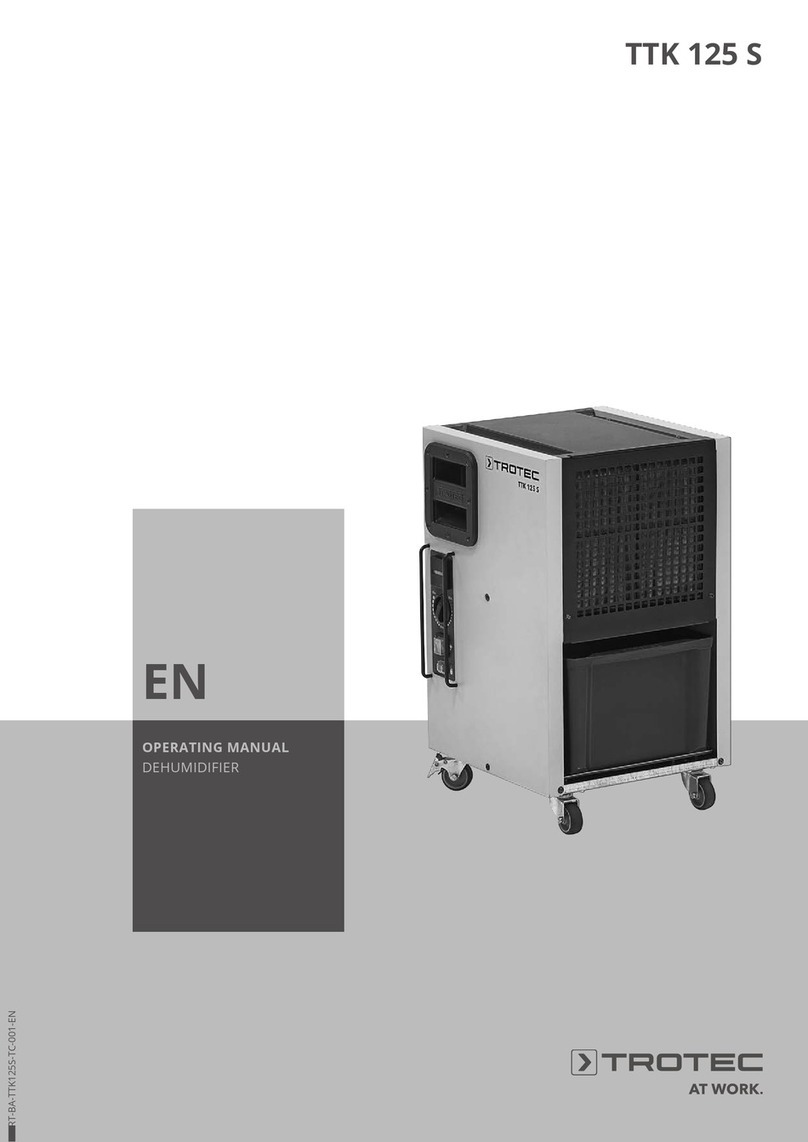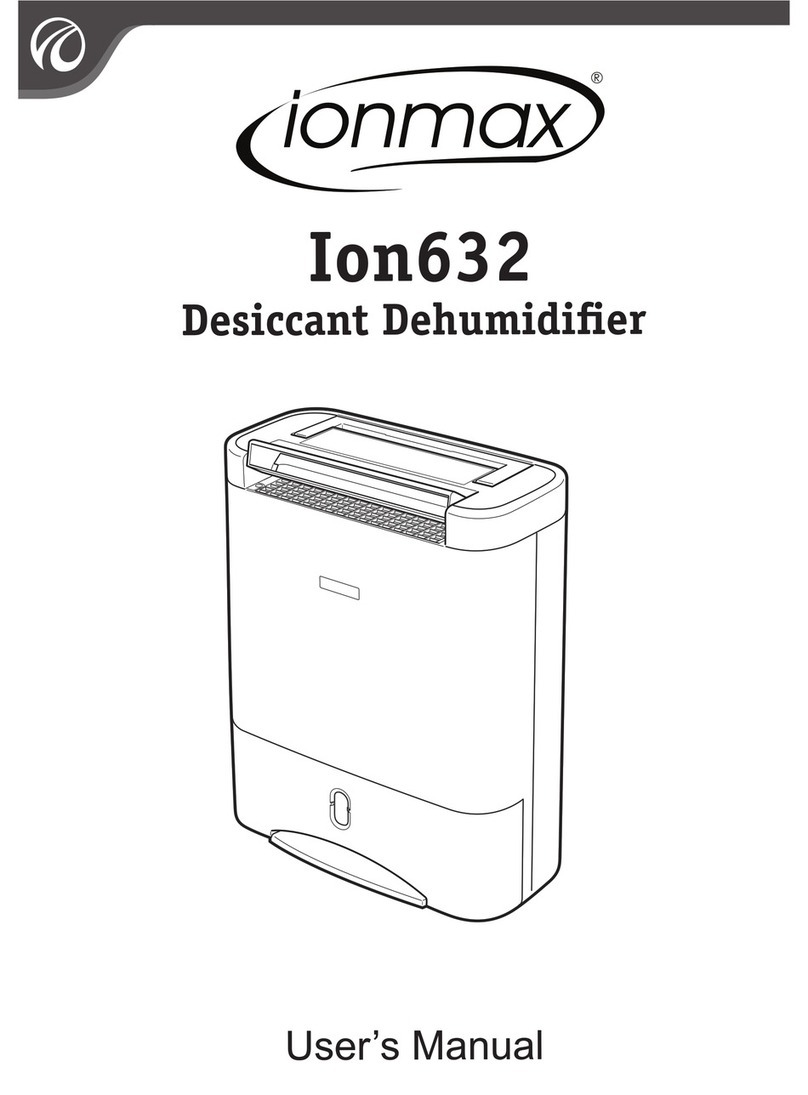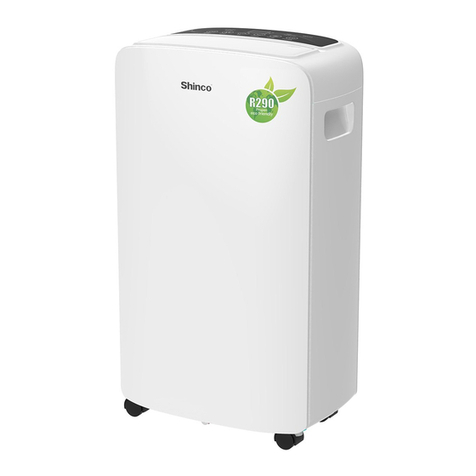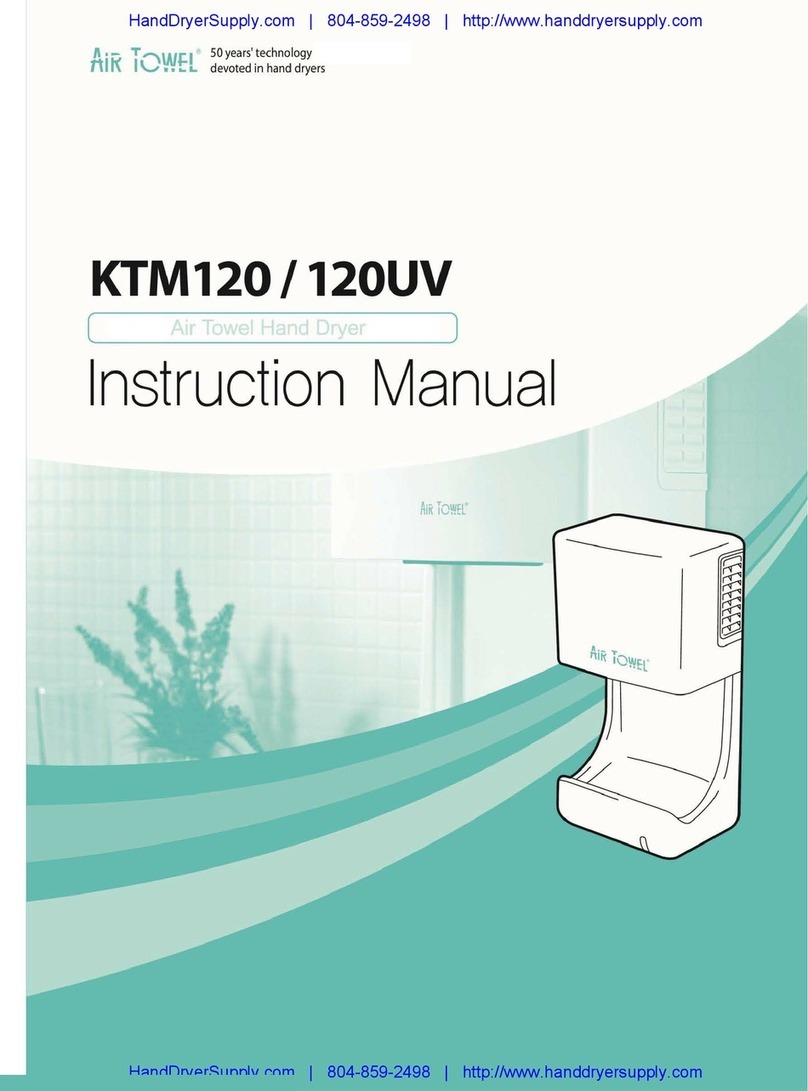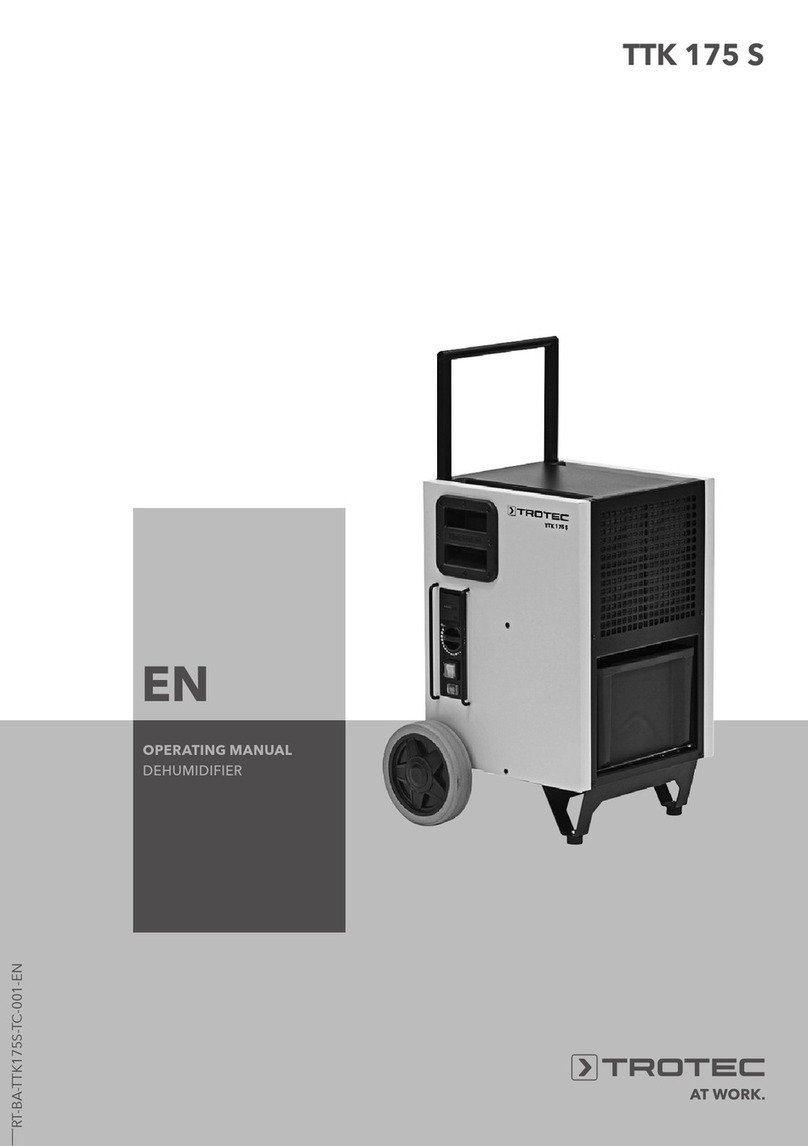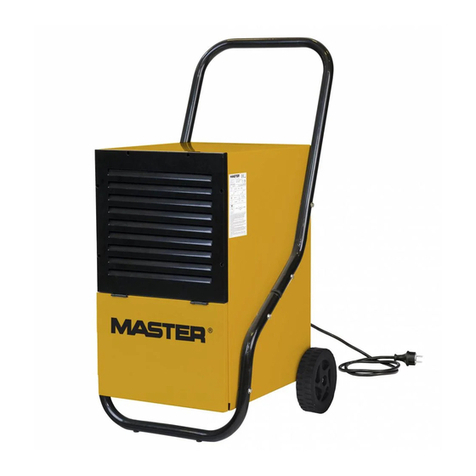Seresco CLASSIC NE Series User manual

NE Series Dehumidifiers
NE-002 and NE-003
NE-204 and NE-206
CLASSIC Indoor Model
Operation and Maintenance Manual
Seresco Technologies Inc. Serescodehumidifiers.com

B –Table of Content
OMM.B.S.SI.00 B-1 June 2018
Table of Content
Chapter C
-
General Information
C
–
1
Operating Safety
C
–
1
Reference and Additional Information
C
–
2
o
Contact Us
C
–
2
Basic Information
C
–
3
o Dehumidifier View and Options
C
–
3
o
Dehumidifier External Systems Connection
C
–
4
o Dehumidifier Optional Arrangement
C
–
5
o Air Conditioning Options – Outdoor Air Condensers and Fluid Coolers
C
–
6
o
Equipment Specific Data
C
–
7
Chapter D
-
Layout and Components
D
–
1
Dehumidifier Main Components
D
–
1
Control System
D
–
2
Outdoor Air Condensers and Fluid Coolers Layout and Components
D
–
4
Chapter E
-
Sequence of Operation
E
–
1
Set Points
E
–
1
Ventilation
E
–
1
Air Conditioning, Dehumidification and Pool Heating
E
–
1
o
Compressor(s)
E
–
1
Space Heating
E
–
3
Chapter F
-
Interface and Communication
F
–
1
Touch Display Operator Panel
F
–
1
o
Alarms
F
–
2
Remote Communication
F
–
3
Chapter M
-
Basic Maintenance
M
-
1
Maintenance and Safety
M
–
1
Maintenance Key Points
M
–
1
Routine Maintenance Program
M
–
2
Specific Components Maintenance
M
–
3
Chapter W
-
Warranty
W
–
1

B –Table of Content
B-2
This page is left blank

C – General Information
OMM.C.S.SI.00 C-1 June 2018
General Information
This manual provides basic information about the applicable Seresco dehumidifier and its operation.
Important information regarding installation, maintenance, and start up as well as additional and auxiliary systems
and devices (outdoor condenser, communication interfaces, etc.) is normally provided with the dehumidifier and
can also be obtained at Seresco (see Contact Us below).
Operating Safety (Warnings, Cautions, and Notes)
FOR YOUR SAFETY: READ BEFORE PERFORMING ANY OPERATIONS, MAINTENANCE OR SERVICE TASKS!
Only qualified technicians should install, operate, maintain or service mechanical equipment
including current dehumidification system.
Make sure to read this manual before performing any tasks to familiarize yourself with the
equipment as well as with any potential hazards. Always exercise caution!
Beware of electrical power and high electrical voltage!
• Follow proper safety procedures – lockout, tagout, and other respective procedures
• Failure to follow safety procedures can result in serious injury or death
Beware of moving parts and hot surfaces!
• Make sure to stop all moving parts (fans, blowers, etc.) before accessing the equipment’s
internal space
• Be aware of hot surfaces (hot refrigeration, space heating pipes, coils, heaters, etc.)
Beware of high pressures and chemicals!
• Dehumidifiers, equipped with compressors, contain refrigerant under high pressure; oil is
also contained in the compressor and refrigeration circuit(s)
• Some dehumidifiers may also contain other liquids such as glycol mixtures and pool water
The following warnings, cautions, and notes appear throughout this manual and referenced documentation
whenever special care must be taken to avoid potential hazards that could result in equipment malfunction or
damage, personal injury, or death.
WARNING
Indicates a potentially hazardous
situation which could result in
serious injury or death if handled
improperly.
CAUTION
Indicates a potentially hazardous
situation which could result in
moderate injury or equipment
damage if handled improperly.
Note
Indicates a situation that could
result in equipment damage or
improper/ineffective operation if
handled improperly.

C – General Information
C-2
Reference and Additional Information
For safe, efficient and problem-free operation, it is critical to handle the dehumidifier (as well as related systems
and components) properly at each step - from receiving and storage to installation and start up. Relevant
information can be found in the respective documents (like Installation Manual) provided with the dehumidifier.
This manual and other related documents could be obtained from the manufacturer (see Contact Us below).
Contact Us
Seresco Technologies website: http://serescodehumidifiers.com
Seresco Online Service Center website: http://service.serescodehumidifiers.com
Headquarters
1071 Ages Drive
Ottawa, ON K1G 6L3
Tel: (613) 741-3603
Fax: (613) 680-5301
Customer Support Team
Email: customersupport@serescodehumidifiers.com
Phone (US): (770) 457-3392 ext. 2
Phone (Canada): (613) 741-3603 ext. 2
Fax: (613) 680-5301
Attention: Installation and Service Contractors
WARNING! Any work (installation, start up, service, maintenance, repair, etc.) on any mechanical
equipment (dehumidifier, outdoor condenser, fluid cooler, etc.) must be performed in accordance with
respective manufacturer’s recommendations as well as submittal documentation, local Codes and Regulations,
and appropriate field practices. Failure to do so could result in personal injury, equipment damage or
malfunction, and will void equipment warranty. Only qualified and properly trained individuals should perform
tasks on this equipment.
Attention: Maintenance Team
CAUTION. To ensure equipment longevity and proper and efficient operation, the dehumidifier and its
auxiliary systems and devices (outdoor condenser, fluid cooler, boiler package, etc.) should be maintained
properly and regularly. Failure to do so could negatively affect premise comfort levels and people’s health. It
could also lead to equipment damage, malfunction, premature tear and ware and may void equipment warranty.

C – General Information
OMM.C.S.SI.00 C-3 June 2018
Basic Information
Dehumidifier View and Options
Standard NE002 – NE003 dehumidifier’s general view and options * are shown on Pic.C.1.
Dehumidifier Options:
Indoor, single-compressor dehumidifiers, 2 and 3 ton cooling capacity (apprx.) - models NE002 to NE003*.
o Two-compressor dehumidifier option (see Dehumidifier Optional Arrangement below for details):
4 and 6 ton cooling capacity (appx.) - models NE204 to NE206;
Airflow and ductwork connection options* (Return, Supply and Outdoor Air) - see Pic. C.1.
Optional Pool Water Heating **.
Optional Space Heating - hot water coil, electric or gas heater ***.
Air Conditioning (AC)* – external water cooling, outdoor condenser or fluid cooler.
Pic. C.1
Options:
Return Air (RA) ductwork connection -
horizontal.
Supply Air (SA) ductwork connection
options – top, bottom, horizontal*.
Outdoor Air (OA) intake - horizontal*.
Piping Connections
① Condensate Drain
② AC – Air-Cooled (refrigeration)
③ AC – Water-Cooled (water/glycol)
④ Pool Heating Water
⑤ Space Heating Hot Water

C – General Information
C-4
* All available options (tonnage, ductwork connections, AC options etc.) are shown. Refer to the submittal
and other relevant documentation for your equipment options, dimensions etc.
** The pool water heating option relies on compressor-created excess heat and is used as an additional
heating source. It does not eliminate the need for a main pool water heater.
*** For specific details on space heating (hot water, gas, electric) option, refer to the submittal and other
documentation:
Gas-fired duct heater can be provided for field installation (to be fitted in the supply air ductwork).
Gas boiler package can also be provided for field installation (to be field-piped to the dehumidifier hot water coil).
Electric heater, depending on various factors (capacity, model, size, etc.), can be installed externally (mounted on the
top of SA opening) or internally. Refer to your dehumidifier’s submittal documentation.
Dehumidifier External Systems Connection
Pic. C.1 shows provisions for external systems connections, including ductwork, electric power and control wires
and various piping connections.
Except for the condensate, all other piping systems are optional and may not be present in each dehumidifier.
Air Conditioning (AC) Connection. Normally, the dehumidifier has only one AC option – air-cooled (requiring
connection to the outdoor air condenser) or water-cooled (requiring connection to the fluid cooler or other
external water-cooled system such as geothermal, cooling tower, etc.). Therefore, only one of these options
present with the actual dehumidifier.
Gas line. If the dehumidifier is equipped with a gas heater (boiler, gas furnace etc.) for space heating
purposes, the gas line connection is to be brought to the gas heater directly.
NOTE. Dehumidifier MUST be equipped with a P-trap at the condensate connection for proper operation! If
dehumidifier is requested/provided from the factory without P-trap, one MUST be installed on site prior to
dehumidifier being commissioned. Refer to the dehumidifier stickers and Installation Manual for details.
CAUTION! Current manual shows general/default connections’ location. For details regarding specific
dehumidifier’s connections (actual location, piping sizes and position dimensions, circuit type and flow direction
etc.), refer to the dehumidifier’s submittal documentation as well as dehumidifier’s labels and stickers.
WARNING! Gas Line. The gas line must be installed in accordance with respective device documentation
(boiler, furnace, etc.) and local codes and regulations.
Attention! Equipment Clearances and Dimensions!
CAUTION! For equipment proper operation, maintenance and service, respective clearances should be
maintained. Generally, 30” clearances to the equipment must be kept for the maintenance and service purposes.
For the specific required clearances information, as well as dehumidifier overall dimensions, distances to pipe
connections, duct connections etc., refer to the submittal documentation.

C – General Information
OMM.C.S.SI.00 C-5 June 2018
Dehumidifier Optional Arrangement.
Two-Compressor Arrangement
Standard NE series dehumidifier has one compressor, however
two-compressor arrangement is available also. Note, that all
options and details, provided above, apply to both, standard and
two-compressor arrangement:
“Double-Decker” dehumidifier is shown on Pic. C.3. It is
composed of two identical dehumidifiers, one installed on
top of another and controlled as a single dehumidifier
(each deck is equipped with one compressor/refrigeration
circuit).
Single and Two-Compressor Arrangement – Dehumidifier Model
Dehumidifier typical arrangement, total capacity, and number of compressors are reflected in its model (for
specific dehumidifier model refer to its Main Label – see Specific Data Info below), as illustrated in examples
below:
NE002 – single-deck single-compressor dehumidifier.
Two -compressor NE series dehumidifier:
NE204 - double-deck two-compressor dehumidifier (composed of two identical dehumidifiers NE002).
Most often, “Double-Decker” comes as two horizontal dehumidifiers, one “stacked” on the top of another,
however it could also be composed of two dehumidifiers (horizontal OR vertical) installed side by side or
separately, still being controlled as one.
Pic. C.3

C – General Information
C-6
Air Conditioning Options - Outdoor Air Condensers (OACC) and Fluid Coolers (OAFC).
Basic views of standard air conditioning options are shown on Pic.C.4 (below); standard combinations of the
dehumidifier and respective air conditioning option (based on their capacities) are shown in Table C.1.
* Table C.1 shows standard dehumidifier and
condenser/cooler combination; depending on number of
factors, dehumidifier may have different condenser/cooler
provided with it - refer to the dehumidifier’s submittal
documentation for more details.
** Two-compressor dehumidifier would normally have
paired-up two outdoor condensers of respective size (one per
compressor).
*** The pump package is optional - the fluid cooler may be provided without it.
Table C.1. Dehumidifier-AC Combination*
Dehumidifier – Outdoor Condenser** Fig.#
NE002 – NE003
NE204 – NE206**
NC-B 1
Dehumidifier – Fluid Cooler*** Fig.#
NE002 – NE003 NG-Z-1 2
NE204 – NE206 NG-V-0 3
Attention! Equipment Clearances!
Proper clearances should be maintained for adequate airflow and heat rejection! Generally, up to 36” side and
96” top clearances are required. For more information on clearances as well as equipment dimensions and other
details, refer to the submittal documentation.
Pic. C.4

C – General Information
OMM.C.S.SI.00 C-7 June 2018
Equipment Specific Data
Specific information for individual dehumidifiers is
provided in the following methods:
Main Label (Pic. C.5): the manufacturer tag attached
to the front of the dehumidifier includes the
dehumidifier’s most critical data:
General data including:
o Serial number
o Dehumidifier model (nomenclature)
o Design room conditions (air temperature
and humidity)
Operational data, including:
o Refrigeration (refrigerant type, charge,
etc.)
o Electrical/airflow (dehumidifier voltage,
CFM, etc.)
o Other applicable data (pool heating,
space/auxiliary heating features, etc.)
Labels and Stickers: attached when applicable to the
exterior and interior of the dehumidifier to show:
External systems connections location/direction
(pool/space heating, cooling circuits, condensate)
Air filter locations, quantity, and size.
Additional Info (warning, caution stickers, etc.)
Wiring Diagrams: attached to the interior side of the
dehumidifier, depict dehumidifier control and power
wiring.
Remotely installed condenser or cooler would have its specific information provided in similar manner (labels etc.).
Attention! Glycol Circuits.
Unless otherwise indicated, equipment fluid circuits (except for refrigeration and pool water circuits) such
as heat
recovery loop, compressor glycol loop, boiler package, fluid cooler etc., are normally filled/to be filled with
water/glycol mixture; normally, rust inhibitor-infused food-grade propylene glycol is used.
Glycol mixture concentration is normally shown on Main Label – refer as needed.
Note:
The main label shown above is just an example.
Pic. C.5

C – General Information
C-8
This page is left blank

D – Layout and Components
OMM.D.S.SI.00 D-1 June 2018
Layout and Components
The general layout and components location is the same for all dehumidifiers of current type, however some may
vary, based on the dehumidifier’s specific options – refer to submittal documentation. Pic. D.1 below shows
all/most available options, some of which may not be present on your dehumidifier.
Dehumidifier Main Components
2
1
3
5
4
7
8
9
11
10
13
14
15
18
17
16
Pic. D.1

D – Layout and Components
D-2
Main Blower (1) is in the main blower compartment next to the Main Electric Panel (2) and Compressor
Compartment (3).
Min Outdoor Air (OA) Opening (4) is optionally equipped with a motorized damper and filter(s). The Manual
OA Damper (5) is usually used to set proper amount of outdoor air intake.
Refrigeration coils - Evaporator (7) and Reheat (internal condenser) (8) - are located directly downstream of
the Main Filter Rack (9).
o Evaporator Bypass Damper (10) is located next to the evaporator coil. It helps to control compressor
suction pressure by adjusting the amount of air, bypassing the evaporator.
Space heater (11) location, if the dehumidifier is equipped with one, may vary:
o Hot water coil is usually located directly downstream of the reheat coil;
o Electric heater may be in the same place as the hot water coil or mounted directly on the
dehumidifier’s supply air duct connection.
o Gas heater (duct heater or boiler package) normally is installed externally.
Compressor (13), Receiver (14) and other components are located within the Compressor Compartment (3).
o If the dehumidifier has the standard pool water heating option, the compressor circuit includes the
coaxial pool water heat exchanger (15) and refrigeration pool valve.
o If the dehumidifier has the water-cooled air conditioning option (equipped with fluid cooler or
connected to external water-cooling source), the compressor circuit also includes the plate heat
exchanger (16)).
Main Electric Panel contains Main Control Board (17), Operator Panel (18) and other electrical components.
Control System
The dehumidifier control system is composed of sensors, spread throughout the dehumidifier, Main Control
Board, Operator Panel and other electric components, located in the Main Electric Panel.
Temperature Sensors (Pic. D.2):
a) Temperature sensors (thermistors) are used to monitor
various temperatures (air, water, compressor, etc.);
b) Combo sensor is used to monitor air temperature and
humidity.
Compressor operation is monitored with pressure sensors (Pic. D.3):
c) Pressure Transducers (as main operational control and safety) and
d) Pressure Switches (fast-reacting backup safety).
Sensors and safeties approximate location is shown on Pic. D.4 .
b
a
c
d
Pic.D.3
Pic. D.2

D – Layout and Components
OMM.D.S.SI.00 D-3 June 2018
RA Combo Sensor (21) measures temperature and humidity of the pool room air (Return Air) entering the
dehumidifier. It is located at the main filter rack.
OA Temperature Sensor (22) measures outdoor air temperature; it’s located at the OA filter rack.
o As an option, the combo sensor (instead of regular thermistor) can be installed at the OA intake to
measure both the temperature and humidity of the outdoor air.
ET (EvapT) Temperature Sensor (23) measures the temperature of air leaving evaporator coil. It’s located
directly downstream of the evaporator.
SA temperature sensor (24) measures the temperature of the air leaving the dehumidifier (supplied to the
premise). It must be located downstream of the space heater:
o In some cases, where the space heater is external to dehumidifier, the sensor will be provided with
the dehumidifier to be field-mounted into the supply air ductwork downstream of the space heater.
If the dehumidifier is equipped with the pool heating option, the Pool Water Temperature sensors (Pool In
(25) and Pool Out (26)) measure the entering and leaving pool water temperature. The sensors are located
directly at the respective connections of the coaxial pool water heat exchanger.
o As an option, the pool water heat exchanger piping/manifold may have water flow switch also.
The compressor’s discharge line (high pressure side) is equipped with Temperature and Pressure sensors set -
Discharge Temperature Sensor, High Pressure Transducer and High Pressure Switch (27) - to protect the
compressor and control its operation. A similar function is performed by Suction Temperature, Low Pressure
Transducer and Switch (28) located at compressor’s suction line (low pressure side).
Main Electric Panel, apart from devices listed above (control board, OP, etc.) also contains Voltage Monitor;
some optional control sensors and devices such as an air pressure differential sensor, current sensor(s). It may
also be located in main electrical panel or in the dehumidifier in general.
Pic. D.4
21
23
24
22
26
27
25
28

D – Layout and Components
D-4
Outdoor Air Condensers and Fluid Coolers Layout and Components.
The general layout of AC options (air-and water-cooled) is shown on Pic.D.5 below with the outdoor air condenser
NC-B-1 (left) and fluid cooler NG-V-0 (right) as an example. While layout and main components are similar for all
applicable AC options, there are some deviations (number of fans, coil sizes, composition, etc.). Refer to AC
Options (Basic Information chapter) for additional information.
Cooling (AC) coil (31) (where heat from refrigerant in the outdoor condenser or glycol mixture in fluid cooler is
rejected to the ambient air) is mounted onto metal frame/air box upstream (before) the fan (32), that pulls
the air through the coil to absorb the heat.
o Condenser/cooler piping connections (33) are identified respectively (IN – OUT, Hot gas – Liquid etc.);
In some cases, fluid cooler piping connection(s) may be located within pump package box
(37), if fluid cooler is provided with one.
Piping connection location may vary – refer to particular cooler/condenser labels, stickers,
submittal and other documentation.
o Depending on the type, size and installation, outdoor condensers may be provided with different set
of legs/supports (34), which are required assembly on-site – refer to the Installation manual.
o Depending on the size and capacity, condenser or cooler may have multiple fans or coils.
Electric power is normally to be brought to disconnect (35) (if cooler/condenser is equipped with such), which
feeds it to the electrical box (36), that contains condenser or cooler power and control apparatuses.
o Depending on type of fluid cooler, location of electrical box may slightly differ.
32
36
35
33
34
37
31
NC-B-1
NG-V-0
Pic. D.5

D – Layout and Components
OMM.D.S.SI.00 D-5 June 2018
Fluid Coolers Pump Package
Fluid Coolers, if equipped with such option, would have a pump package box. Pic.D.6 below shows general layout
of pump packages, used for NG-Z (left) and NG-V (right) fluid coolers. Note that the package used with NG-V
coolers could be mounted onto the fluid cooler directly (standard) or provided separately.
Pump (38) establishes glycol mixture circulation through the fluid cooler and dehumidifier;
Expansion tank (39) compensates for temperature-based glycol volume fluctuation;
The pump package electrical sub-panel (40) contains the pump package electrical power and control
apparatuses.
o Due to the compact design of the fluid cooler NG-Z, the electrical sub-panel includes power and
control apparatuses for the fluid cooler and the pump package itself.
The pump package manifolds are usually equipped with pressure gauges, automatic air venting valve, draining
and other valves.
40
38
39
38
40
39
Pic. D.6
NG-Z NG-V

D – Layout and Components
D-6
This page is left blank

E – Sequence of Operation
OMM.E.S.RS.00 E-1 June 2018
Sequence of Operation
The dehumidifier’s ventilation system establishes the required airflow through the dehumidifier. The control
system compares air temperature and humidity to their desired values (set points) and proceeds to dehumidify,
cool or heat the recirculating air.
If the dehumidifier is equipped with the pool water heating option, the pool water temperature is compared to its
set point and pool heating is provided if required.
Set Points
The control system is constantly adjusting unit operation to achieve and maintain said parameters within couple
degrees/percent of the set point.
Refer to the dehumidifier’s main label for the design value of control parameters, as well as the following note.
Ventilation.
The main blower runs continuously, establishing required airflow and pulling fresh outdoor air onto the premise
through the minimum outdoor air intake (OA1) damper. The main blower speed is pre-set via adjustable variable
signal.
Dehumidifier, though usually does not have it built-in, can control the external minimum exhaust fan (EF1), to
directs portion of return air outdoors. Like the main blower, exhaust fan speed is controlled via adjustable (pre-set)
variable signals: the exhaust fan speed may vary depending on scheduled ventilation mode (Occupied, Non-
Occupied and Spectator) or call for Economiser Mode (as part of Air Conditioning and/or Dehumidification
operation).
Note. Externally installed Exhaust Fan(s) and Outdoor Air damper(s) could be also controlled by the
dehumidifier control system. This applies to both, Minimum and Purge/Additional, fans and dampers.
Air Conditioning, Dehumidification and Pool Heating.
Compressor(s)
Whenever the compressor operates, the evaporator is always dehumidifying and cooling the return air. The heat
removed from the air at the evaporator, as well as the heat from the compressor's action, must be rejected to one
of three heat sinks: room (premise) air, pool water (if applicable) or outdoors. The control system will direct the
heat to where it is needed based on room (air and pool water temperature) conditions:
If room air is needed to be warmed up – more heat is diverted towards reheat coil;
If pool water is needed to be warmed up – more heat is diverted towards pool heating coaxial heat exchanger
(if dehumidifier is equipped with this option).
Rest of the heat (if any) is diverted towards outdoors (outdoor condenser, fluid cooler, etc.)
Note: To ensure the dehumidifier’s most economical operation, we recommend maintaining the following
relationship between pool water and room air temperatures:
Room Air T = Pool Water T + 2˚F

E – Sequence of Operation
E-2
Compressor Circuit Operation
Piping schematic for compressor circuit is shown on Pic. E.1.
When a demand requires the compressor to operate, the following sequence occurs:
Once blower operation, related safeties and timers are confirmed by the control system, the pump down
solenoid valve opens and once pressure stabilizes, the compressor starts.
Based on the premise air temperature, the refrigeration reheat and/or AC solenoid valve opens, allowing
refrigerant to flow through the respective condenser:
o if more heat is required by the room air, the reheat solenoid valve opens (heat is rejected to the
premise); if more cooling is required by the room air, the AC solenoid valve opens (heat is rejected
outdoors (via outdoor condenser or plate heat exchanger).
o Outdoor condenser or fluid cooler fan is engaged only if hot gas is diverted outdoors and compressor
pressure is higher than pre-set level (see Outdoor Condenser and Fluid Cooler Operation below).
Dehumidifiers, equipped with pool water heating option, also engage the refrigeration pool water heating
solenoid valve to reject heat into the pool water, based on pool water temperature.
Once demand for the compressor’s operation is removed (respective call is satisfied), the pump down solenoid
valve closes; once the compressor suction pressure reaches the pre-set pressure, the compressor stops.
Outdoor Air Condenser and Fluid Cooler Operation.
Based on the type of the outdoor condenser or fluid cooler fans’ type (two-speed fans or EC-type/modulating
fans), respective signal(s) are sent by control system to engage said fan(s): for two-speed fans - on/off signals
(switching speeds, based on compressor head pressure level), for EC-type fans - variable 0-10VDC signal
(proportional to the compressor head pressure level). Refer to the fans’ type and wiring diagram if/when needed.
If the fluid cooler is equipped with the built-in pump package (to establish cooling fluid flow between dehumidifier
and the fluid cooler or to serve as additional/booster pump), the said pump is also engaged along with fluid cooler
fans – pump would stay engaged while fans are engaged (regardless of the fans’ speed).
Pic. E.1

E – Sequence of Operation
OMM.E.S.RS.00 E-3 June 2018
Space Heating
When premise air temperature drops below the set point, the dehumidifier control system issues a call for Space
Heating Mode and engages space heater (electric heater, hot water coil with valve, gas boiler etc.) by sending space
heating signal, respective to space heater control type - on/off, variable (0-10VDC), etc.
Gas Boiler Package, one of the available space heating options, is a closed-loop water/glycol heating circuit, that
consists of a hot water coil, instantaneous gas boiler, pump and mixing 3-way valve. Boiler package piping general
schematic is shown on Pic. E.2 (depending on required capacity, boiler package could be single or double (as shown
on picture)):
The pump is engaged and maintains constant water flow whenever space heating call exists. The mixing
valve responds to the space heating call – the more heat is needed the hotter water is diverted towards the
space heating coil. Boiler is controlled and operated via its own control system, responding to proper gas
pressure, water flow, and will supply glycol at a constant temperature.
Pic. E.2
This manual suits for next models
4
Table of contents
Other Seresco Dehumidifier manuals
